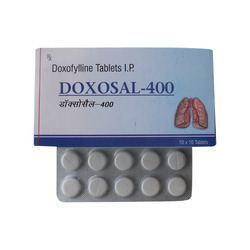Routes ofadministration By mouth CAS Number 69975-86-6 Formula C11H14N4O4 | ATC code R03DA11 (WHO) PubChem CID 50942 Molar mass 266.25 g/mol | |
 | ||
AHFS/Drugs.com International Drug Names Legal status In general: ℞ (Prescription only) | ||
Doxofylline (also known as doxophylline) is a xanthine derivative drug used in the treatment of asthma.
Contents
How to pronounce doxofylline
Medical uses
It has antitussive and bronchodilator effects, and acts as a phosphodiesterase inhibitor.
In animal and human studies, it has shown similar efficacy to theophylline but with significantly fewer side effects.
Chemistry
Unlike other xanthines, doxofylline lacks any significant affinity for adenosine receptors and does not produce stimulant effects. This suggests that its antiasthmatic effects are mediated by another mechanism, perhaps its actions on phosphodiesterase.
Names
It is marketed under many brand names worldwide, including: An Li Nuo Er, An Sai Ma, Ansimar, Asima, Bestofyline, Chuan Ning, D-Fyal, Dilatair, Doxiba, Doxobid, Doxobron, Doxofilina, Doxofillina, Doxofyllin, Doxofylline, Doxofylline, Doxofylline, Doxoll, Doxophylline , Doxovent, Doxyjohn, Fei Te Ai Si, Jian Fang Neng, Lang Ming, Lv Meng, Mai Ping Xi, Maxivent, Mucosma, Na De Lai, Phylex, Phyllin, Puroxan, Rexipin, Shu Zhi, Shuai An, Shuweixin, Suo Di, Suo Ji, Suo Li An, Xi Si Nuo, Xin Qian Ping, Xin Xi Ping, Yi Suo, and Yili.
It is also marketed as a combination drug with terbutaline as Doxoll-TL, Mucosma-T and Phylex-TR.
It is also marketed as a combination drug with montelukast as Doxoll-ML, Doxomont , Doxoril-M, Doxovent-M, Lunair-M, and Venidox-M.
